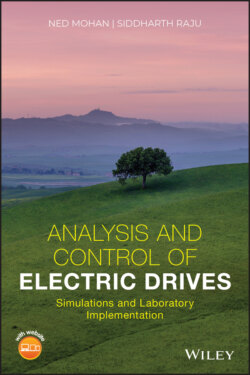Читать книгу Analysis and Control of Electric Drives - Ned Mohan - Страница 9
Оглавление
PREFACE
Electric machines and drives are used in all aspects of our life wherever electricity is used. Nearly all the electricity is generated through electric generators and drives. Almost two‐thirds of this electricity is consumed by motor‐driven systems in the United States. There are opportunities for energy savings by making generators and motors more efficient. In addition, substantial energy savings can be obtained by converting motors that operate at essentially constant speed to variable speed drives, where the motor speed is efficiently controlled to match the system requirements, thus resulting in substantial system‐wide energy savings. There are emerging applications, such as electric vehicles, robotics, and drones, where precise speed and position control are essential. All these applications demand vector‐controlled ac drives that are discussed in this textbook.
This textbook is divided into three parts. Part I of this textbook covers the fundamental principles that govern ac machines and electric drives. Using these fundamentals as the basis, the steady‐state operation of ac machines and drives is analyzed in Part II. These two parts can be the basis for an undergraduate course, as we have at the University of Minnesota.
In a graduate course on this topic, students may not have the requisite background of what was covered in the undergraduate course using Parts I and II. Therefore, a quick review is warranted prior to the dynamic control of ac drives for precise speed and position, using vector control of ac drives. This is covered in Part III of this textbook.
A NEW APPROACH
This textbook is intended for a first course on the subject of electric machines and drives where no prior exposure to this subject is assumed. To do so in a single‐semester course, a physics‐based approach is used that not only leads to a thorough understanding of the basic principles on which electric machines operate, but also shows how they ought to be controlled for maximum efficiency. Moreover, electric machines are covered as a part of electric‐drive systems, including power electronic converters and control, hence allowing relevant and interesting applications in wind turbines and electric vehicles, for example, to be discussed.
This textbook describes systems under steady‐state operating conditions. However, the uniqueness of the approach used is that it seamlessly allows the discussion to be continued for analyzing and controlling of systems under dynamic conditions using vector control in a graduate‐level course.
For discussion of all topics in this course, computer simulations are a necessity. These simulations utilize MATLAB/Simulink and the Sciamble Workbench (http://www.sciamble.com) – a University of Minnesota startup. The simulations in Sciamble Workbench can be seamlessly implemented to control hardware, as demonstrated by hardware experiments in an associated laboratory, to complement courses taught using this textbook.
